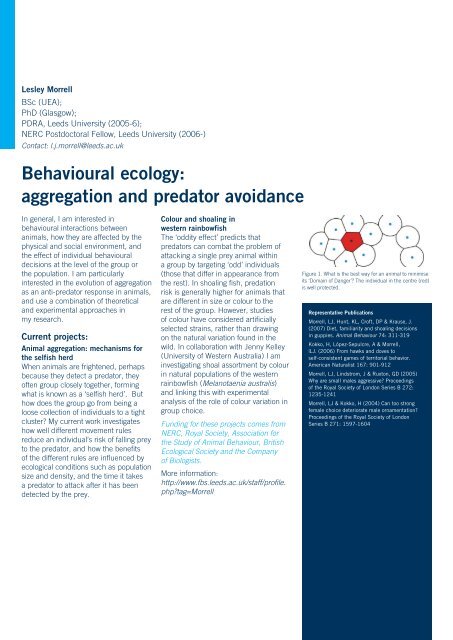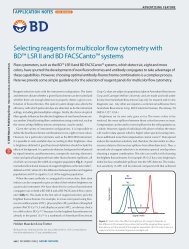3649-08 IICB.indd - Faculty of Biological Sciences - University of ...
3649-08 IICB.indd - Faculty of Biological Sciences - University of ...
3649-08 IICB.indd - Faculty of Biological Sciences - University of ...
You also want an ePaper? Increase the reach of your titles
YUMPU automatically turns print PDFs into web optimized ePapers that Google loves.
Lesley Morrell<br />
BSc (UEA);<br />
PhD (Glasgow);<br />
PDRA, Leeds <strong>University</strong> (2005-6);<br />
NERC Postdoctoral Fellow, Leeds <strong>University</strong> (2006-)<br />
Contact: l.j.morrell@leeds.ac.uk<br />
Behavioural ecology:<br />
aggregation and predator avoidance<br />
In general, I am interested in<br />
behavioural interactions between<br />
animals, how they are affected by the<br />
physical and social environment, and<br />
the effect <strong>of</strong> individual behavioural<br />
decisions at the level <strong>of</strong> the group or<br />
the population. I am particularly<br />
interested in the evolution <strong>of</strong> aggregation<br />
as an anti-predator response in animals,<br />
and use a combination <strong>of</strong> theoretical<br />
and experimental approaches in<br />
my research.<br />
Current projects:<br />
Animal aggregation: mechanisms for<br />
the selfish herd<br />
When animals are frightened, perhaps<br />
because they detect a predator, they<br />
<strong>of</strong>ten group closely together, forming<br />
what is known as a ‘selfish herd’. But<br />
how does the group go from being a<br />
loose collection <strong>of</strong> individuals to a tight<br />
cluster? My current work investigates<br />
how well different movement rules<br />
reduce an individual’s risk <strong>of</strong> falling prey<br />
to the predator, and how the benefits<br />
<strong>of</strong> the different rules are influenced by<br />
ecological conditions such as population<br />
size and density, and the time it takes<br />
a predator to attack after it has been<br />
detected by the prey.<br />
Colour and shoaling in<br />
western rainbowfish<br />
The ‘oddity effect’ predicts that<br />
predators can combat the problem <strong>of</strong><br />
attacking a single prey animal within<br />
a group by targeting ‘odd’ individuals<br />
(those that differ in appearance from<br />
the rest). In shoaling fish, predation<br />
risk is generally higher for animals that<br />
are different in size or colour to the<br />
rest <strong>of</strong> the group. However, studies<br />
<strong>of</strong> colour have considered artificially<br />
selected strains, rather than drawing<br />
on the natural variation found in the<br />
wild. In collaboration with Jenny Kelley<br />
(<strong>University</strong> <strong>of</strong> Western Australia) I am<br />
investigating shoal assortment by colour<br />
in natural populations <strong>of</strong> the western<br />
rainbowfish (Melanotaenia australis)<br />
and linking this with experimental<br />
analysis <strong>of</strong> the role <strong>of</strong> colour variation in<br />
group choice.<br />
Funding for these projects comes from<br />
NERC, Royal Society, Association for<br />
the Study <strong>of</strong> Animal Behaviour, British<br />
Ecological Society and the Company<br />
<strong>of</strong> Biologists.<br />
More information:<br />
http://www.fbs.leeds.ac.uk/staff/pr<strong>of</strong>ile.<br />
php?tag=Morrell<br />
Figure 1. What is the best way for an animal to minimise<br />
its ‘Domain <strong>of</strong> Danger’? The individual in the centre (red)<br />
is well protected.<br />
Representative Publications<br />
Morrell, LJ, Hunt, KL, Cr<strong>of</strong>t, DP & Krause, J.<br />
(2007) Diet, familiarity and shoaling decisions<br />
in guppies. Animal Behaviour 74: 311-319<br />
Kokko, H, López-Sepulcre, A & Morrell,<br />
|LJ. (2006) From hawks and doves to<br />
self-consistent games <strong>of</strong> territorial behavior.<br />
American Naturalist 167: 901-912<br />
Morrell, LJ, Lindstrom, J & Ruxton, GD (2005)<br />
Why are small males aggressive? Proceedings<br />
<strong>of</strong> the Royal Society <strong>of</strong> London Series B 272:<br />
1235-1241<br />
Morrell, LJ & Kokko, H (2004) Can too strong<br />
female choice deteriorate male ornamentation?<br />
Proceedings <strong>of</strong> the Royal Society <strong>of</strong> London<br />
Series B 271: 1597-1604










